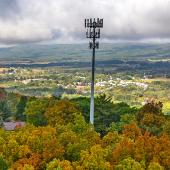On scene, in the patrol vehicle, and at the command post — wherever law enforcement officers work, they need fast and reliable connectivity. One of the most important innovations for public safety communications is 5G. With 5G, wireless connectivity can move more data at greater speeds in near real time. 5G will have a big impact on the ability of officers to do their jobs safely and efficiently.
Investing in 5G for the future of FirstNet
At the FirstNet Authority, we make sure that FirstNet, public safety’s network, is evolving to meet the needs of law enforcement and other first responders.
That’s why we announced a series of strategic investments totaling more than $8 billion over 10 years. These investments usher in the next phase of FirstNet, transitioning it to a full 5G network for first responders.
The FirstNet Authority is making these investments to ensure FirstNet remains at the forefront of technology, continues to solve the communications challenges facing public safety today, and has the flexibility to adapt to public safety’s future needs.
5G means speed and reliability for law enforcement
For law enforcement, 5G means faster and more reliable access to data. One benefit of a 5G network is increased capacity, which transmits data at ultra-high speeds and with ultra-high reliability.
Reliability matters for situational awareness. The Burleson County Sheriff’s Office in Texas uses its drone program to monitor situations without sending officers in person. They have used drones to search for missing persons, plan rescues during flooding, and assess hazardous material spillage from a train derailment.
“When you're talking about a live video, [reliability] is crucial because you could have a threat appear. And what the drone operator is seeing live or what the commanders are seeing to make some type of a decision, that has to be a reliable device,” said Chief Deputy John Pollock.
With FirstNet and 5G, law enforcement can power wireless technologies like drones with faster speeds. Officers must be able to trust the reliability and timeliness of their incoming data, especially when responding to incidents.
5G enables near real-time streaming
Another feature of 5G important to law enforcement operations is low latency. Low latency reduces lag and delay, making communications as close to real time as possible.
Near real-time communications are especially critical when livestreaming video from an active scene. The Daytona Beach Police Department in Florida uses livestreaming body cameras every time an officer is dispatched for the officer’s safety and for tactical advantage.
Officer Monica Lee is the agency’s body camera administrator and trainer. She stressed the importance of real-time video transmission for officers’ body cameras. “Because we use cameras for officer safety, buffering and glitches can’t be overlooked,” she said.
The low latency features of 5G ensure that there are little to no glitches or buffering because the network is responding faster. When video is livestreamed without lags, officers, dispatchers, and supervisors can make faster, more informed decisions.
5G can move massive amounts of data
Today’s law enforcement officers rely on access to information. Whether through the Internet of Things (IoT) or virtual incident command posts, wireless transmission of data is critical to law enforcement operations.
IoT has a network of sensors and connected devices that delivers useful data to law enforcement operations. Data sources can include everything from gunshot detection sensors and license plate readers to wearable health monitors and streetlight sensors. These IoT devices demand greater capacity and ultra-high speeds to transmit massive amounts of data. 5G networks have the capability to connect one million devices per square kilometer, a huge increase over current capabilities.
Law enforcement operations are becoming increasingly decentralized — with virtual incident command posts and patrol vehicles as mobile offices. In both cases, a tremendous amount of data must be processed in the field.
The Oakland County Sheriff’s Office piloted a mobility project to enable deputies to use their smartphones as a one-stop shop communications tool. Using a docking station in their vehicle, deputies can do everything from dispatching to accessing secure databases and more. This gives deputies the flexibility to access data while maintaining maximum mobility on duty.
5G will allow more devices to connect and deliver information at once, which is helpful as law enforcement operations become more mobile and virtual.
To learn more about how FirstNet is helping public safety and the law enforcement community to leverage innovative public safety communications, sign up for the Law Enforcement Take with Harry Markley.




















